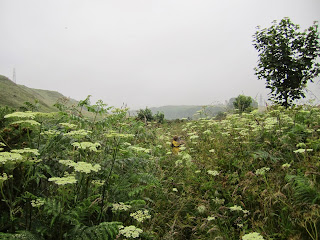The video Wind, Willow, Water combines photographs by Yiannitsa
Cegarra with words and sounds by Petra Vergunst. It is the product of a
collaborative project that started with a morning of fieldwork in the
floodplains of the river Dee at Newton Dee, Bieldside. The video expresses the
shared experiences and feelings about the place and reflections on doing
fieldwork together. What struck Yiannitsa and Petra was the contrast in
expressive opportunities of their media as photography produces still images
whilst poetry and music are time-based media that can communicate movement and
change. They found this contrast between stillness and movement reflected in
the landscape. To communicate the calmness of the river landscape, they chose
to work with a limited number of images, words and types of sounds and develop
these organically.
Yiann says: Wind, Willow, Water has been my first project in
collaboration with another OCA student. I must say that it has been invaluable
to have worked with Petra. It has reinforced the importance of communication
and engagement with another student face-to-face and in particular how the flow
of ideas and experiences are shared. Also, I have realised that a higher level
of commitment is needed as I haven’t experienced working with another artist
before; it was something I was prepared – and needed – to do, and I found it
very exciting. I came to know how different disciplines work and I was amazed
at how Petra was able to create such pieces – both the poem and the soundtrack
– by remembering her experiences from Newton Dee and the feelings gathered
through my images. At the start I got to feel the place, which was new to me,
and then set out to gather evidence of everything I saw while pre-visualising
how I would process the images. I gave Petra sets of colour and black and white
versions of the photographs to choose from to see if it was in accordance to
our shared experiences of the place. The best bit for me was listening to her
poem for the first time, absolutely magical; and then work with my images in
harmony – which was tricky. The soundtrack came in last and it wraps up the
project entirely; it reflects our experience of the land in nearly all senses –
visual, feeling and sound. I cannot emphasise enough how important it has been
for me to work with Petra, it has given me the strength to be confident as an
artist and it has opened new ways of engaging and creating work that takes me
out of a limited comfort zone. I think that our project Wind, Willow, Water is
a good starting point for collaboration across disciplines in our studies and I
hope that there will be many to come in the future, and I also hope that it
will inspire other OCA students to work in partnership.
Petra says: This collaborative project with Yiannitsa has
been very exciting. What we aimed for was an integration of art forms, not one
of us responding to the work of the other. We did fieldwork together and
discussed our ideas on a regular basis. Doing fieldwork together was a real
eye-opener. Yiannitsa took out her camera and started taking photographs while
I was not sure what to do. This made us realise how a photographer needs a
landscape to produce his or her art while a composer is looking for remembered
feeling, that is, the experience of a place, something that not necessarily has
to be recorded whilst out there. In the end, Yiannitsa sent me several
photographs that I took as a starting point for my poem, a recording of which
Yiannitsa then used to create a first video. Following a discussion she decided
to make several alterations, after which I eventually added sound effects
(using a treble recorder). In a way, the project was as much about the process
of collaborating as producing an actual video. What helped us a lot was sending
each other links to work that we felt was relevant to our joint project – more
than once a WeAreOCA blog. We even went to the premiere of Chris Dooks’ Tiny Geographies,
a film based on still images of landscape with a soundtrack consisting of found
poetry. This shared frame of reference helped us look critically on what we
were doing ourselves. Collaborating with Yiannitsa has been important for my
development as an artist. Not only has it made me do things that were out of my
comfort zone and reflect on things I take for granted as a composer of music, it
also revealed the kind of questions artists – irrespective of the art form they
are working in - are dealing with. I very much hope that this project has been
a first step in a longer process of collaboration – with Yiannitsa and others.
See also:
The music of poetry
See also:
The music of poetry
Copyright text and video Yiannitsa Cegarra and Petra Vergunst



.jpg)
.jpg)






